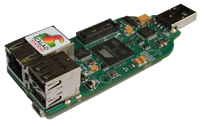At last, real hardware in our training sessions
If you haven’t had a look at our new training agendas, you may not have noticed that we now use real hardware in our embedded Linux and kernel training sessions. For 4 years, we had been using the QEMU emulator on the x86, arm and mips platforms. While this simplified training session logistics, and avoided any trouble due to hardware failures, this was not close enough to the real world situations that our customers face.
We chose the nifty boards from Calao Systems. They have great features that make them very attractive for training and prototyping purposes
- AT91SAM9263 ARM CPU from ATMEL, running at 200 MHz
- 64 MB of RAM and 256 MB of flash, which are more than enough for any embedded system we can think of.
- Small and light (30 g), with a USB connector replacing power, serial and JTAG connectors, making it easy to travel with several of these devices without having to carry many heavy accessories. Carrying convenience was a key decision factor.
- 100 Mbit Ethernet port, allowing to practice with root filesystems on NFS, and with tftp from the U-boot command line.
 2 USB 2.0 host ports, allowing to connect any type of device. In particular, we are thinking about USB mass storage and webcam devices.
2 USB 2.0 host ports, allowing to connect any type of device. In particular, we are thinking about USB mass storage and webcam devices.- 1 USB device port, allowing to experiment with Linux USB gadget drivers.
- Very affordable price (less than 160 €).
On the software side, this board is also very attractive:
- It is supported by the mainline Linux kernel, since version 2.6.27.
- A bricked board can be reflashed without ever needing to use Windows, thanks the Linux version of Atmel’s SAM-BA utility.
- It will soon be supported by the mainline version of U-boot. We are contributing to this.
- It should also be directly supported in the mainline version of Buildroot in the next months, making it easy to build complete root filesystems for it. We will also work on this.
We will also soon offer training cost options that include these boards. This way, customers can walk away with their own device and easily continue to practice with the training hardware and make prototypes, without having to go through an extra purchasing process.

Hi Michael,
It’s a good idea!
Practical exercices on embedded Linux must be done on real hardware. I’m not a fan of qemu and prefer to have real 3D targets with real bugs 🙂
Cheers;
Pat